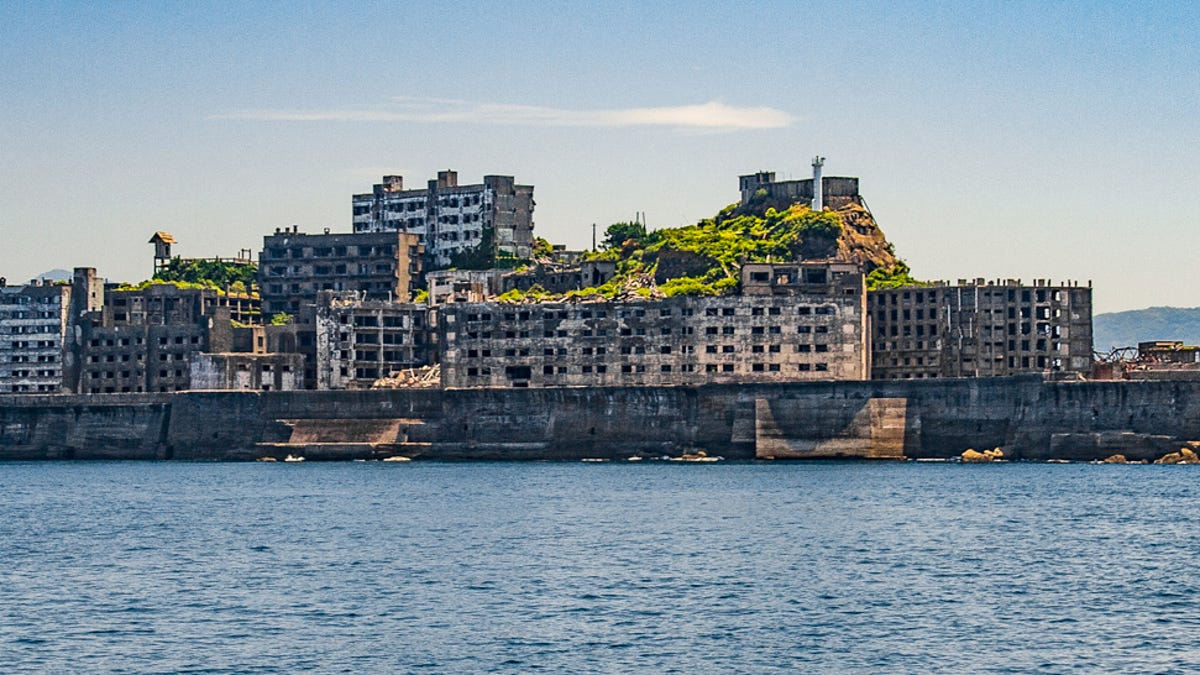 Why You Can Trust CNET
Why You Can Trust CNET Behold the haunting decay of Gunkanjima, Japan's 'Battleship Island'
Hashima was abandoned in 1974 and left to the elements. Storms, time, and decay have resulted in collapsed buildings that feel inhabited by the ghosts of the miners who used to live there. Here's a tour.

Battleship Island. It's a fantastic name for an unbelievable place. A place unlike any in the world. A tiny island, once home to 5,259 people with the highest population density in history, abruptly abandoned and left to the elements for decades.
The result is haunting and fascinating. If you've played any of the recent installments in of the post-apocalyptic Fallout series of games, prepare yourself for profound deja vu. The apartment towers have been left to decay. Typhoons have battered windows and walls. Waves have smashed buildings and barriers. It's an incredible sci-fi location come to life.
And you can go there.
For years, Hashima -- also known as Gunkanjima or "Battleship Island" -- was off limits. Abandoned in 1974 and left to rot, the buildings had become unsafe. Yet it was so close to Nagasaki one could sneak onto the island, and many did.
In 2009 a new dock was built, along with walkways and viewing areas, so the general public could experience a piece of this amazing place. Buy a ticket, get an all-too-short tour.
So I did just that. Here are the pictures.
From Hashima to Gunkanjima
In the late 1800s, Japan ran on coal. Its appetite was insatiable. Enough so that when coal was discovered on the islands near Nagasaki, it was somehow logical to start a mine there. By 1920, 3,271 people lived on Hashima. As the mines got deeper, more personnel were needed.
When they ran out of room on top, they started reclaiming land from the sea. The 16-acre island we see now is three times the size of the one nature built. Imposing seawalls offered a modicum of protection, but more importantly, they granted more land to build on. They also gave the island a new shape, one of a massive battleship. "Gunkanjima," literally "Battleship Island," was born.
At its peak, 5,259 people lived on Hashima, an equivalent of a population density of 216,264 people per square mile. Not just miners, but minors and mothers too. Hashima was a tiny city, with schools and shops, two public pools and more. The hundreds of families that squeezed onto Hashima often lived six to a single apartment.
Though the lack of privacy was an issue, the mine employees were well paid and were early adopters of TVs and other "luxury" goods. There was also, apparently, no crime on the island.
As Japan moved away from coal, expensive mines like Hashima became unprofitable. By the early '60s, the mines were so deep it would take workers two hours to get to the mine face. In 1974, Mitsubishi pulled the plug. The mine would close, though most workers would be relocated to mines elsewhere in the country, if desired.
Many belongings were left behind as the thousands of families abandoned their homes for the mainland.
And suddenly, for the first time in nearly a century, Hashima was silent.
Without humans to keep entropy at bay, the sun and the surf, the wind and the weather, all took their toll. The once bustling micro-city decayed, becoming a haunting relic on the edge of the sea.
By the '90s, two decades had had their way with the Island. The legend of the place spread with the Internet. Urban adventurers sneaked onto the island to explore this rare and specific type of ruins. Getting to the island wasn't difficult per se. But it wasn't easy, either. Many, like myself, became fascinated with this unique place.
Then the new dock was built, and tours began. I went with Gunkanjima Concierge as they had an audioguide in English and cost 4,000 yen, about $40.
In 2015, Hashima was granted World Heritage Status (not without some controversy). The island city was featured on TV shows like "Life After People," and was a setting for Raoul Silva's lair in "Skyfall"(though most scenes were shot on a set, not in actual Hashima).
Are the modern, sanitized tours as good as what exploring this place was like 10 or more years ago? Almost certainly not. For one, you only get to walk around a small section of the island, nowhere near the dilapidated buildings. You also walk on bright, new concrete, with railings to keep you in. At least you don't have to worry about getting brained by a chunk of falling concrete. Or a Super Mutant.
Google Street View might sate your appetite as to what the rest of the island looks like now. For more, check out the 360 videos I took of the observation area and the island's southern end.
It's magical to be in this singular place, where so many once lived, loved and worked. Now it's a reminder of endings. Of the creativity of man. Of the ultimate and final power of nature.
As well as covering audio and display tech, Geoff does photo tours of cool museums and locations around the world, including nuclear submarines, aircraft carriers, medieval castles, epic 10,000-mile road trips and more.
Also check out Budget Travel for Dummies, his travel book, and his bestselling sci-fi novel about city-size submarines. You can follow him on Instagram and YouTube.

